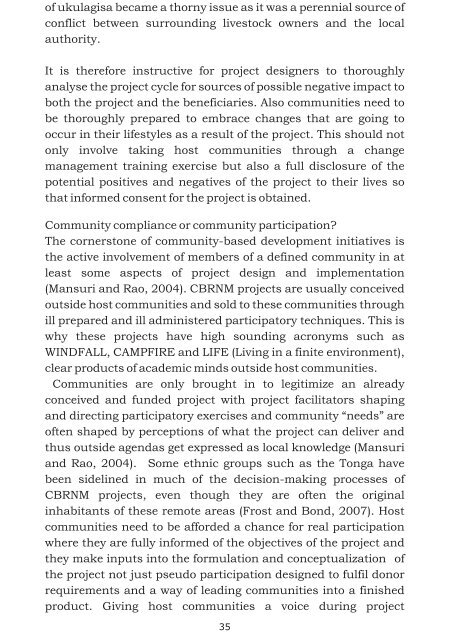Beneficiaries are actors too.pdf - Southern Institute of Peace ...
Beneficiaries are actors too.pdf - Southern Institute of Peace ...
Beneficiaries are actors too.pdf - Southern Institute of Peace ...
Create successful ePaper yourself
Turn your PDF publications into a flip-book with our unique Google optimized e-Paper software.
<strong>of</strong> ukulagisa became a thorny issue as it was a perennial source <strong>of</strong><br />
conflict between surrounding livestock owners and the local<br />
authority.<br />
It is therefore instructive for project designers to thoroughly<br />
analyse the project cycle for sources <strong>of</strong> possible negative impact to<br />
both the project and the beneficiaries. Also communities need to<br />
be thoroughly prep<strong>are</strong>d to embrace changes that <strong>are</strong> going to<br />
occur in their lifestyles as a result <strong>of</strong> the project. This should not<br />
only involve taking host communities through a change<br />
management training exercise but also a full disclosure <strong>of</strong> the<br />
potential positives and negatives <strong>of</strong> the project to their lives so<br />
that informed consent for the project is obtained.<br />
Community compliance or community participation?<br />
The cornerstone <strong>of</strong> community-based development initiatives is<br />
the active involvement <strong>of</strong> members <strong>of</strong> a defined community in at<br />
least some aspects <strong>of</strong> project design and implementation<br />
(Mansuri and Rao, 2004). CBRNM projects <strong>are</strong> usually conceived<br />
outside host communities and sold to these communities through<br />
ill prep<strong>are</strong>d and ill administered participatory techniques. This is<br />
why these projects have high sounding acronyms such as<br />
WINDFALL, CAMPFIRE and LIFE (Living in a finite environment),<br />
clear products <strong>of</strong> academic minds outside host communities.<br />
Communities <strong>are</strong> only brought in to legitimize an already<br />
conceived and funded project with project facilitators shaping<br />
and directing participatory exercises and community “needs” <strong>are</strong><br />
<strong>of</strong>ten shaped by perceptions <strong>of</strong> what the project can deliver and<br />
thus outside agendas get expressed as local knowledge (Mansuri<br />
and Rao, 2004). Some ethnic groups such as the Tonga have<br />
been sidelined in much <strong>of</strong> the decision-making processes <strong>of</strong><br />
CBRNM projects, even though they <strong>are</strong> <strong>of</strong>ten the original<br />
inhabitants <strong>of</strong> these remote <strong>are</strong>as (Frost and Bond, 2007). Host<br />
communities need to be afforded a chance for real participation<br />
where they <strong>are</strong> fully informed <strong>of</strong> the objectives <strong>of</strong> the project and<br />
they make inputs into the formulation and conceptualization <strong>of</strong><br />
the project not just pseudo participation designed to fulfil donor<br />
requirements and a way <strong>of</strong> leading communities into a finished<br />
product. Giving host communities a voice during project<br />
35


